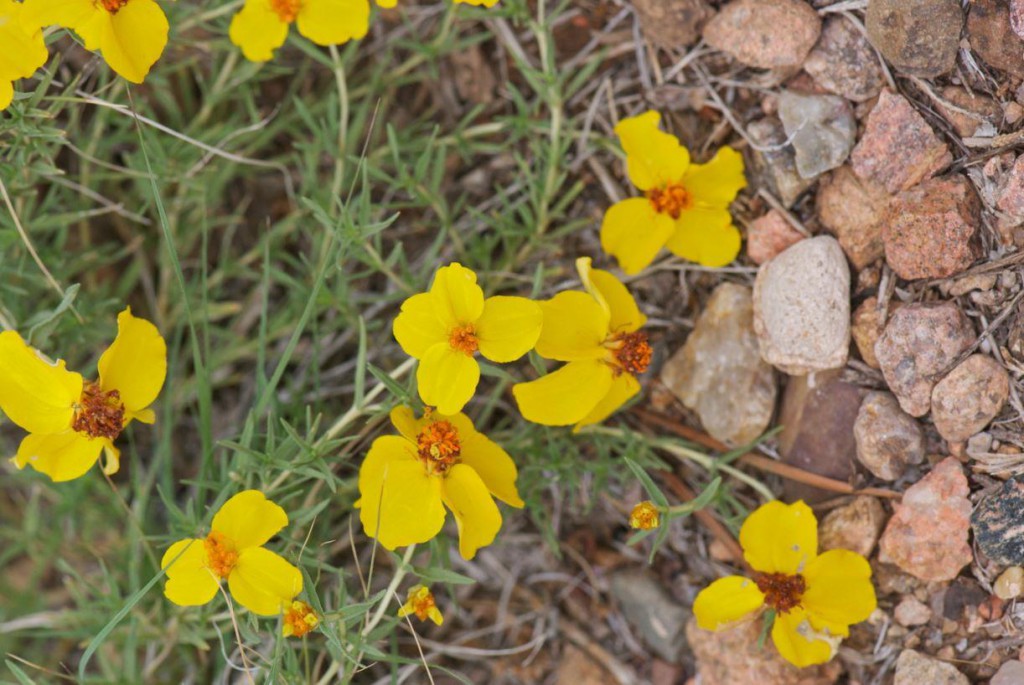Scientific name: Zinnia grandiflora
Synonym: Crassina grandiflora
Common names: prairie zinnia, golden eye, plains zinnia, little golden zinnia, Rocky Mountain zinnia, yellow zinnia
Family: Asteraceae (Compositae)
Article by Jeanne Gozigian

Zinnia grandiflora flower (Photo credit: Janice Tucker)
We recently moved from Santa Fe, New Mexico, to a Del Webb 55+ community which is in Bernalillo, a suburb of Albuquerque, New Mexico. I am not giving up my allegiance to the Botanical Garden at Museum Hill, located in Santa Fe, despite my lack of physical proximity. Ironically, all of the streets of my new neighborhood are named after wild flowers and I now live on Prairie Zinnia Drive. What else could I do but feature prairie zinnia for my “Plant of the Month” article? The High Country Gardens website claims that prairie zinnia “lives forever.” Do I need another reason to plant this in the garden of my twilight years?
You will notice that “Zinnia” is sometimes spelled, “Zimnia.” Linnaeus named the species for Johann Gottfried Zimn, a German anatomist and botanist (1727-1759), a professor of medicine and director of a botanical garden in Gottingen. Grandiflora (grandiflorus) refers to big or showy flowers. When in Mexico, studying botany, Zimn was accosted by banditos. They decided that he was crazy after searching his backpack, which had only plant samples. They let him pass. Crassina grandiflora, the synonym, refers to crassia, meaning somewhat thick.

Southwest Desert Flora, http://southwestdesertflora.com, Photo: Gene Sturla
Prairie zinnia can bloom from May through October, depending on its location, in the United States. It finds homes in Colorado, Arizona, Kansas, Oklahoma, New Mexico, and Texas; in Mexico, it grows south to Zacatecas. It does well on dry, gravelly slopes and mesas. It is happy in very rugged terrain with full sun. The soil can be clay or sandy, limestone/chalky, with low water availability. It is deer and rabbit resistant and attracts butterflies. In other words, it is one tough kid!
All this, and very pretty, too! The “shrub-like” perennial has much-branched stems rising from a woody base. The stems have multiple 1-1 ½ inch florets with three to six yellow ray flowers and golden/orange tubular disc flowers in the center, typical of plants in the aster family. This color palette explains one of its common names – golden eye. The opposite, linear, bright green leaves are covered with short, rough hairs. In zones 4-9, it welcomes neighbors such as cacti and penstemons.
Because it spreads by rhizomes, it is excellent for erosion control and is a natural for planting in rock gardens, parkways and medians. It can be four inches tall by fifteen inches wide. Sow seeds, which may need cold and moisture stratification, in fall or spring, in succession; that is, plant seeds a few at a time, over a week or month, because a low germination rate is possible. Prairie zinnia is commercially available as plants in pots. It can be an annual in some areas, but is usually deemed a perennial. Although it can tolerate very low water usage, it flourishes with initial watering. Dead-head to encourage repeat blossoming and divide in early summer.
David Salman of High Country Gardens, tells a story about a color variation of Zinnia grandiflora on the nursery website:

Zinnia grandiflora habit (Photo credit: Janice Tucker)
He found, over the border into Colorado, a mass of Zinnia grandiflora in full bloom with a patch of gold-flowered specimens in their midst that had blue/green foliage. He collected the seeds, which he found to have great vigor. He called gave this selection the cultivar name, ‘Gold on Blue’. Because they make excellent ground cover, he suggested that they be used to plant the so-called “Inferno Strips,” between street and sidewalk in urban settings.
The Victorians believed in the symbolic meanings of flowers, which they called the “language of flowers.” Zinnias stood for affection, endurance and the remembrance of absent friends, my exact feeling for my beloved colleagues and The Botanical Garden at Museum Hill in Santa Fe, New Mexico.
At the Botanical Garden at Museum Hill, in Santa Fe, New Mexico, prairie zinnia can be found in the Arroyo Overlook area in the Ojos y Manos section of the Garden.
I give thanks to Helen Woody and Janice Tucker, colleagues at the Leonora Curtin Wetland Preserve, an adjunct of The Botanical Garden at Museum Hill, for proofreading this article.
Sources:
www.flowermeaning.com/zinnia-flower-meaning
Lady Bird Johnson Wildflower Center
Latin for Gardeners, Lorraine Harrison
Stearn’s Book of Plant Names for Gardeners, William T. Stearn
Sunset Western Garden Book, edited by Kathleen Norris Brenzel
The Plant List, theplantlist.org
Wikipedia


